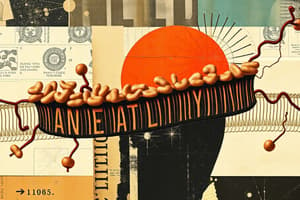Podcast
Questions and Answers
The cell membrane is also known as the ______ membrane.
The cell membrane is also known as the ______ membrane.
plasma
The rate of an enzyme-catalyzed reaction can be affected by factors such as ______, temperature, and substrate concentration.
The rate of an enzyme-catalyzed reaction can be affected by factors such as ______, temperature, and substrate concentration.
pH
A ______ is a short chain of amino acid monomers linked by peptide bonds.
A ______ is a short chain of amino acid monomers linked by peptide bonds.
peptide
The ______ of electrons is known as reduction, while the loss of electrons is known as oxidation.
The ______ of electrons is known as reduction, while the loss of electrons is known as oxidation.
Biomolecules can be classified into four main categories: ______, lipids, proteins, and nucleic acids.
Biomolecules can be classified into four main categories: ______, lipids, proteins, and nucleic acids.
Phospholipids are composed of ______, two fatty acids, and a phosphate group.
Phospholipids are composed of ______, two fatty acids, and a phosphate group.
Carbohydrates are classified as either simple or ______ sugars.
Carbohydrates are classified as either simple or ______ sugars.
[Blank] is the storage form of glucose in animals, stored in the liver and muscle.
[Blank] is the storage form of glucose in animals, stored in the liver and muscle.
Lipids are made from ______, hydrogen, and oxygen.
Lipids are made from ______, hydrogen, and oxygen.
The ______ bond is the type of bond that links amino acids together in proteins.
The ______ bond is the type of bond that links amino acids together in proteins.
Nucleic acids play an essential role in the storage, transfer, and expression of ______ information.
Nucleic acids play an essential role in the storage, transfer, and expression of ______ information.
The discovery of nucleic acid is credited to ______ Miescher in 1868.
The discovery of nucleic acid is credited to ______ Miescher in 1868.
Flashcards are hidden until you start studying
Study Notes
Cell Membrane
- Composed of 4 types of molecules: phospholipids, proteins, and peripheral proteins (loosely bound to the surface of the membrane)
Enzyme Affecting Factors
- 6 factors affecting enzyme activity:
- pH (acidity/basicity): measures hydrogen ion (H+) and hydroxide ion concentration
- Temperature: increasing temperature increases the rate of reaction
- Substrate: increasing substrate concentration increases the rate of reaction
- Oxidation: loss of electrons
- Reduction: gain of electrons
- Redox enzymes: catalyze redox reactions between two molecules
Biological Macromolecules
- Large organic molecules: carbohydrates, lipids, proteins, and nucleic acids
- Monosaccharide: simplest form of carbohydrates
- Monomer: a molecule that reacts with other molecules to form large molecules or polymers
- Hormones: special chemical messengers created in endocrine glands
- Amino acids: organic compounds that combine to form proteins
- Enzymes: proteins that make biochemical reactions faster
- Nucleotide: composed of nitrogen-containing base, five-carbon sugar, and a phosphate group
- Phospholipids: contain glycerol, two-fatty acids, and a phosphate group
Biological Macromolecules (Detailed)
Carbohydrates
- Carbohydrates may be broken down to carbon and hydrate
- Also known as saccharide
- Classified as simple (monosaccharides and disaccharides) or complex (polysaccharides)
- Monosaccharides:
- Glucose: used in dextrose, blood sugar; utilized by the human body
- Galactose: found in milk and milk products
- Fructose: found in fruits and honey
- Disaccharides:
- Maltose: glucose + glucose; found in malt
- Sucrose: glucose + fructose; found in regular table sugar, sugarcane, and sugar beet
- Lactose: glucose + galactose; found in milk and milk products
- Polysaccharides:
- Starch/amylose: storage form of glucose in plants
- Amylopectin: storage form of glucose in plants
- Glycogen: storage form of glucose in animals; stored in the liver and muscles
- Cellulose: structural material in plants; cell wall in wood, wood fiber (can't be digested by humans)
Lipids or Fats
- Important in the body, but excessive consumption can lead to heart disease, cancer, and obesity
- Classifications: triglyceride, phospholipid, wax, and steroid
- Examples: fats and oils
- Made from carbon, hydrogen, and oxygen
- Soluble in oil, insoluble in water
- Function: long-term energy storage in the body
- Monomer: fatty acid
Proteins
- Examples:
- Keratin
- Fibroin/Silk protein
- Collagen
- Enzymes:
- Lipase
- Pepsin
- Sucrase
- Myoglobin
- Made from carbon, hydrogen, oxygen, and nitrogen
- Made up of amino acids combined through peptide bonds
- Monomer: amino acid
- Two classes:
- Saturated fats: two carbons attached to each carbon (except the one at the end); unhealthy fats like butter
- Unsaturated fats: missing at least one hydrogen, curled in shape; healthy, includes oils
Nucleic Acids
- Play an essential role in storing, transferring, and expressing genetic information
- Discovered by Friedrich Miescher in 1868
Studying That Suits You
Use AI to generate personalized quizzes and flashcards to suit your learning preferences.




